Japanese fish last through sun-drying because of two key factors working together: salt and precise drying techniques. When you apply the right amount of salt (3-10%), it draws moisture from the fish's tissue, creating an environment where bacteria can't thrive. The traditional Japanese method then uses controlled sun exposure at temperatures between 30-40°C with 50-60% humidity, typically over several days. You'll find fishermen carefully turning the fish and monitoring weather conditions to guarantee even drying. This preservation technique not only prevents spoilage but also concentrates the fish's nutrients and enhances its flavors – a process that holds centuries of culinary wisdom within its simplicity.
The Ancient Art of Preservation
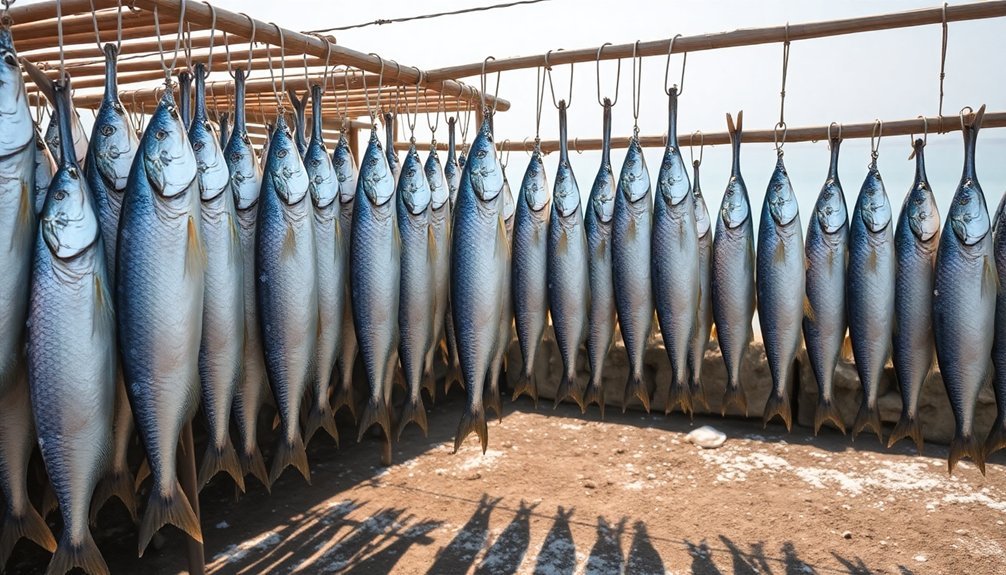
Long before modern refrigeration transformed food storage, Japanese fishermen mastered the delicate art of fish preservation through sun-drying and fermentation. Through generations of practice, they developed sophisticated techniques that didn't just prevent spoilage but also enhanced the fish's flavor and texture. With fish containing approximately 80% water, understanding moisture control was crucial to their preservation success.
You'll find that these preservation methods weren't merely practical solutions – they represented a deep cultural connection to the sea and its bounty. The ancient technique of narezushi, which combines fish fermentation with rice and salt, creates a distinctive umami-rich product that's become a cornerstone of Japanese culinary tradition.
What makes these preservation methods particularly effective is their focus on moisture removal. When you remove water from fish through sun-drying, you're fundamentally creating an environment where harmful bacteria can't thrive. The process requires careful attention to air movement, temperature, and humidity levels – skills that Japanese artisans have refined over centuries.
Today, you can still witness these traditional methods alongside modern adaptations. While contemporary tools like dehydrators and vacuum sealers have enhanced efficiency, the fundamental principles of these ancient preservation techniques remain unchanged, continuing to influence how fish is preserved worldwide.
Salt's Role in Fish Drying
When you use salt in Japanese fish drying, you're harnessing one of nature's most effective preservatives to draw moisture from the fish tissue and create an environment where harmful bacteria can't thrive.
Using coarse sea salt provides the most effective results due to its purity and superior moisture-drawing properties.
You'll need to carefully control salt concentrations to achieve the right balance between preservation and flavor, as higher concentrations extend shelf life but can make the fish too salty.
Your success in managing water activity levels depends on applying the right amount of salt, which transforms the fish's texture while creating the perfect conditions for sun-drying.
Salt As Natural Preservative
Salt stands as the cornerstone of traditional fish preservation in Japanese sun-drying methods. When you apply salt to fish, it draws out moisture through osmosis, creating an environment where harmful bacteria can't survive. The salt penetrates the fish tissue, changing its protein structure and delivering both preservation benefits and flavor enhancement. Salt brine injection can accelerate the absorption process for faster preservation.
You'll find that proper salt concentration is vital for effective preservation. A range of 3-10% salt content works best, with higher concentrations extending shelf life but intensifying saltiness. Whether you're using dry salting or brine solutions, guaranteeing even coverage prevents spoilage and maintains consistent quality.
- Salt dehydrates fish tissue to less than 48% moisture content
- Creates an inhospitable environment for spoilage bacteria
- Transforms protein structures for better texture and durability
- Concentrates flavors while developing rich umami notes
When you've properly salted your fish, you can expect it to last for months or even years under the right storage conditions. Keep your dried fish in a cool, dark place at 2-4°C to maximize its shelf life.
The combination of salt preservation and proper storage guarantees your sun-dried fish maintains its quality and distinctive flavor profile.
Managing Water Activity Levels
Three key factors determine successful fish preservation: temperature, salt concentration, and water activity levels. Among these, water activity (aw) plays an important role in determining whether microorganisms can grow on your fish. Unlike moisture content, aw measures the energy of water available for microbial growth on a scale of 0 to 1.0.
When you're sun-drying fish, you'll want to achieve an aw level below 0.85, as this prevents most pathogenic bacteria from multiplying. Salt is your ally in this process. When you apply salt to fish tissue at concentrations of 6-10%, it binds water molecules, making them unavailable for bacterial growth. This creates an osmotic imbalance that microorganisms can't tolerate.
You'll get the best results by combining salting with sun-drying. While salting reduces the water activity, drying removes the actual moisture content. Together, they create a powerful preservation method.
Remember that while low water activity won't kill existing bacteria, it'll prevent new pathogens from growing. That's why it's important to start with fresh, high-quality fish and maintain proper hygiene during the preservation process.
Salt Concentration Techniques
Building on water activity control, proper salt concentration methods form the backbone of successful fish preservation.
You'll find that Japanese sun-dried fish relies heavily on precise salt applications, typically maintaining a 6-10% concentration in fish tissue to prevent bacterial growth.
When you're working with salt preservation, you'll need to choose between dry salting or wet brining methods, each offering distinct advantages for different fish types.
For ideal salt concentration in Japanese fish preservation, you should follow these key steps:
- Select food-grade salt with minimal calcium and magnesium content to avoid bitter tastes and texture problems.
- Maintain temperatures below 3°C for dry salting or 10°C for brining to guarantee proper preservation.
- Use salt-to-fish ratios between 1:3 and 1:10, depending on fish size and thickness.
- Allow 24-48 hours of salt contact time while making sure of even distribution through regular stirring if using brine.
Once you've completed the initial salting process, you'll need to wash the fish in a light brine solution to remove excess salt.
This step is vital as it prevents over-salting while maintaining the necessary preservation levels for successful sun-drying.
Weather and Drying Time
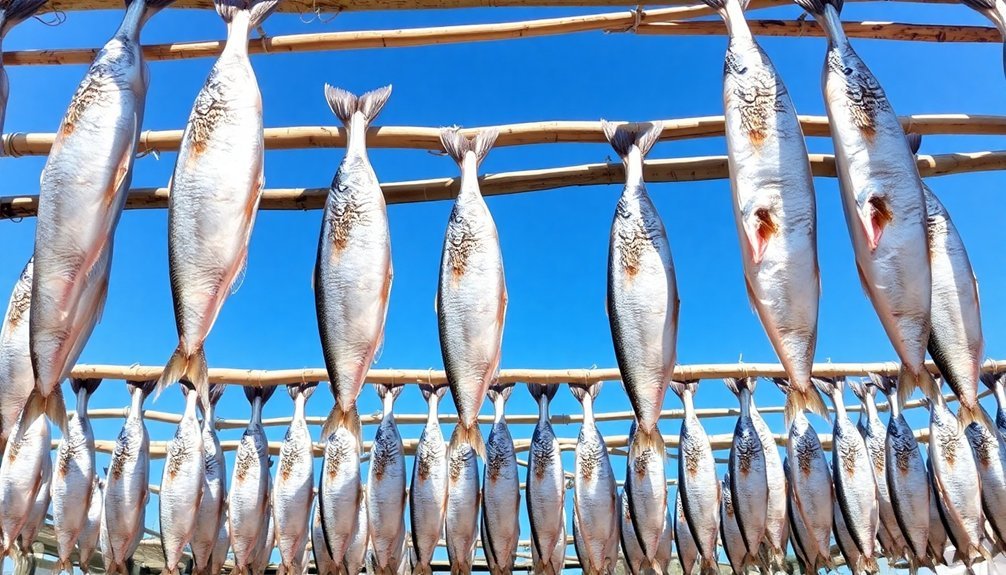
The success of Japanese fish sun-drying heavily depends on proper weather conditions and timing. You'll find that ideal temperatures between 30°C and 40°C provide the best environment for drying fish, while maintaining a relative humidity of 50-60% guarantees efficient moisture removal. Japan's coastal regions often provide these perfect conditions, especially during specific seasons.
You'll need to dedicate several days to a week for proper sun-drying, with active drying occurring during 8-hour daylight periods when the sun's intensity is strongest. It's vital that you turn the fish regularly to achieve uniform drying and prevent spoilage. You can enhance the process by choosing locations with gentle breezes, as they aid in evaporation.
Weather variability will greatly impact your drying time, so you'll want to monitor weather forecasts carefully. You should cover your fish at night to protect them from moisture and pests, and consider using raised racks or frames to promote air circulation.
During extreme weather conditions, you might need to move your fish to sheltered areas while still maintaining adequate ventilation. This careful balance of exposure and protection guarantees your fish dry properly and develop the desired preservation characteristics.
Japanese Traditional Drying Methods
Japanese fish preservation masters have developed four distinct drying techniques that showcase centuries of expertise: sun-drying, salted-and-dried, grilled-and-dried, and boiled-and-dried methods.
Each approach serves a specific purpose in preserving fish while enhancing its natural flavors and textures.
1. Sun-drying is the most straightforward method – you'll find fish gutted, cleaned, and laid out to dry under direct sunlight.
This technique concentrates the umami taste while requiring careful monitoring of temperature and humidity.
2. In salted-and-dried processing, you're working with either full salting or brine immersion at 10-20% concentration.
The salt doesn't just preserve; it transforms the fish's flavor profile.
3. When you're using the grilled-and-dried method, you'll start by cooking the fish over a shichirin or irori.
This step eliminates fishy odors while adding a charcoal-grilled aroma before the drying begins.
4. The boiled-and-dried technique starts with cooking fish in brine or fresh water.
You'll notice this process denatures proteins and deactivates enzymes, making the subsequent drying more effective.
These methods can also be combined with modern techniques like freeze-drying and smoking for specialized products.
From Ocean to Table
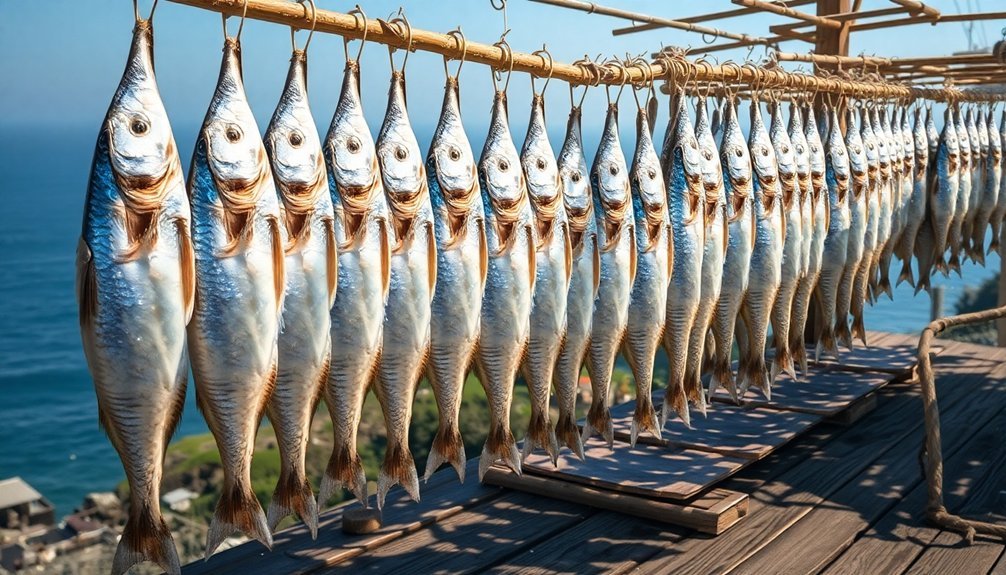
While traditional drying methods set the foundation for Japanese fish preservation, mastering the journey from ocean to table requires meticulous attention at every step.
You'll find that the process begins immediately after catching suitable fish like mackerel, horse mackerel, or sardines. The fish must be gutted and thoroughly cleaned to prevent any internal organs from compromising the preservation process.
Once you've cleaned and descaled the fish, you'll need to apply salt – approximately one-third of the fish's weight. This vital step draws out moisture and creates an environment hostile to bacteria.
You can then proceed with the initial drying, either through sun exposure or controlled environments like dehydrators set at 160-180°F.
Modern techniques have revolutionized the drying process. You'll find infrared, heat pump, and vacuum drying systems that offer precise control and faster results than traditional sun drying.
These methods guarantee consistent quality while preventing contamination. After drying, you'll want to store your fish in airtight containers or vacuum-sealed packages.
For proper presentation, position the fish with its head pointing left and tail right, a technique that skillfully conceals any imperfections.
Choosing the Right Fish
When you're preparing to sun-dry fish in the Japanese tradition, you'll want to focus on lean species like cod, flounder, and halibut that contain minimal oils to prevent quick spoilage.
Your fish must be absolutely fresh, ideally caught the same day, as the quality of dried fish directly depends on the initial freshness of your raw ingredients.
The fat content of your chosen fish is essential, so stick to species with firm, low-oil flesh that will dry evenly and store well over time.
Best Species for Drying
Selecting the right fish species is essential for successful sun-drying. In Japanese tradition, certain fish characteristics make them more suitable for this preservation method. You'll want to look for fish with naturally high protein content and lower initial moisture levels, as these traits contribute to better drying results and longer storage life.
When choosing fish for sun-drying, you'll find that both freshwater and marine species can work well, but they must meet specific criteria for ideal results. The best candidates will retain their minerals during the drying process while developing concentrated protein levels.
- Look for fish with high initial protein content, as the drying process will further concentrate these nutrients.
- Choose species with naturally lower moisture content to reduce drying time and prevent spoilage.
- Select fish known for good mineral retention, particularly those rich in iron and zinc.
- Consider traditional Japanese choices like sardines (used for Niboshi), which have proven successful through generations of drying.
Remember that successful sun-drying isn't just about the process – it starts with picking the right species. You'll get better results by choosing fish that naturally align with the preservation method's requirements.
Fat Content Matters Most
Fat content plays a pivotal role in successful fish sun-drying, with higher-fat species requiring special attention during the process. When you're selecting fish for sun-drying, you'll need to take into account that fat concentration increases considerably during dehydration. For instance, fish like P. sophore can show nearly triple the crude fat content after drying compared to its fresh state.
You'll get the most nutritional benefits from properly dried fatty fish, as they're packed with beneficial omega-3 fatty acids, particularly EPA and DHA. A 200g portion of dried smelts provides about 4.4g of omega-3s, equivalent to roughly 20 fish oil supplements. However, you'll need to handle these fatty fish with extra care during the drying process.
To preserve the quality of fats in your fish, you'll want to guarantee proper drying techniques. Use protective netting to keep insects away and maintain consistent drying conditions to prevent lipid oxidation.
Unlike smoking, which can decrease essential fatty acid levels, proper sun-drying helps maintain the fatty acid profile while concentrating these beneficial nutrients through dehydration.
Freshness Before Processing
Three key indicators signal a fish's suitability for sun-drying: bright, clear eyes, firm flesh that springs back when pressed, and a fresh ocean scent.
You'll want to guarantee your fish meets these criteria before beginning the drying process, as freshness directly impacts the final product's quality and shelf life.
To maintain peak freshness before processing, you'll need to handle the fish with precision and care.
Modern fishing operations use immediate freezing techniques on boats to preserve cell integrity, while traditional markets rely on quick processing and careful temperature control.
Here's what you'll need to check when selecting fish for sun-drying:
- The fish must be freshly caught and processed immediately to prevent quality degradation
- Storage temperature shouldn't exceed 25°C to avoid unwanted fermentation
- The flesh should be free from bruising or damage that could affect drying
- For best results, choose lean fish varieties like mackerel, horse mackerel, or cod
The Science Behind Preservation

Behind the time-tested practice of Japanese fish sun-drying lies a fascinating scientific process that guarantees preservation through moisture removal. When you expose fish to sunlight for 5-7 days, you're actually triggering a complex dehydration process that makes the fish hostile to microorganisms that cause spoilage.
| Process | Effect |
|---|---|
| Water Removal | Prevents bacterial, yeast, and mold growth |
| Protein Changes | Increases crude protein through dehydration |
| Nutrient Concentration | Enhances vitamins D, sodium, iron, and zinc |
| Amino Acid Retention | Preserves essential amino acids like lysine |
| Extended Shelf Life | Enables storage for several years |
You'll find that sun-drying doesn't just preserve – it transforms. The process concentrates nutrients per unit weight as moisture evaporates, leading to higher levels of crude protein and fat. While you'll lose some vitamins A, E, and K, you'll gain increased amounts of vitamin D and minerals. The science shows that moisture migration from the fish's interior to its surface creates a preservation effect that's been reliable for centuries. This process makes the fish stable at ambient temperatures and easy to transport, explaining why it's remained a practical preservation method in Japanese cuisine.
Essential Tools and Equipment
Traditional Japanese fish sun-drying requires the right combination of bamboo or wooden drying racks placed at ideal heights to guarantee proper air circulation around your fish.
You'll need specialized salt distribution tools, such as fine-mesh strainers or shakers, to apply an even coating of salt that aids in preservation and flavor development.
Managing airflow is essential to successful drying, so you'll want to use adjustable screens or bamboo blinds that help control exposure to wind and sun while protecting the fish from insects and debris.
Drying Racks and Surfaces
Proper drying racks stand up from and out above the ground, forming the backbone of Japanese fish sun-drying operations. You'll find these racks elevated about one meter high, constructed from either metal or wooden stands, and covered with food-grade mesh. This elevation isn't random – it's vital for creating ideal air movement and keeping your fish away from swampy areas.
The mesh covering serves multiple essential purposes in the drying process:
- Prevents smaller fish from falling through the gaps
- Protects against dust and sand contamination
- Keeps insects and other contaminants away
- Provides a secure surface while allowing air circulation
You'll want to guarantee your racks are equipped with protective features like plastic sheets for unexpected rain. The mesh size should be small enough to secure the fish while still allowing proper airflow.
When you're setting up your drying station, remember that the rack's height and construction directly impact the quality of your dried fish. These elevated platforms create a clean, controlled environment that's necessary for achieving the perfect dry.
You'll notice the difference in both drying time and final product quality when using properly constructed racks.
Salt Distribution Materials
Effective salt distribution requires a carefully chosen set of tools and containers for peak fish preservation. You'll need specific equipment to guarantee proper salt penetration and avoid common preservation problems like salt burn or uneven distribution.
| Equipment Type | Primary Function |
|---|---|
| Cement Tanks | Layered stacking with ideal drainage |
| Rubber Containers | Portable salting with drainage holes |
| Palm/Coconut Baskets | Wet salted fish packaging |
| Polyethylene Containers | Squid and seasoning storage |
| Weighting Tools | Enhanced salt penetration |
To maximize preservation, you'll want to use clean cement tanks for large-scale operations, as they provide the perfect environment for layering fish with salt. For smaller batches, you can opt for rubber containers with proper drainage holes. When it comes to packaging wet salted fish, palmyrah or coconut leaf baskets offer excellent ventilation and moisture control. You'll find polyethylene containers particularly useful for storing squid and seasonings during the drying process. Don't forget to apply weights from the top of your containers – this vital step guarantees thorough salt penetration throughout the fish layers, leading to better preservation results.
Air Flow Management Tools
Managing air flow in Japanese fish drying depends on an integrated system of specialized tools and equipment.
You'll need precise control over air circulation to achieve the perfect dried fish texture, and modern drying facilities incorporate both traditional wisdom and contemporary monitoring tools.
Essential air flow management tools for Japanese fish drying include:
- Built-in air flow meters that simultaneously track temperature and humidity levels, allowing you to maintain ideal drying conditions.
- Adjustable chimneys with variable heights to control thermosiphoning effects, which you can modify based on weather conditions.
- Black-surfaced drying tables with food-grade mesh that enhance heat absorption while guaranteeing proper air circulation around each fish.
- Clear polyethylene coverings that seal to the chimney system, creating a controlled environment for consistent drying.
You'll want to position your drying setup in a flat area with maximum sun exposure, using angled collectors to boost efficiency by up to 12%.
The chimney system's design guarantees continuous air movement, while real-time monitoring helps you adjust conditions based on temperature-induced air density changes.
For best results, you'll need to take regular measurements and record air flow rates throughout the drying process.
Seasonal Impact on Drying
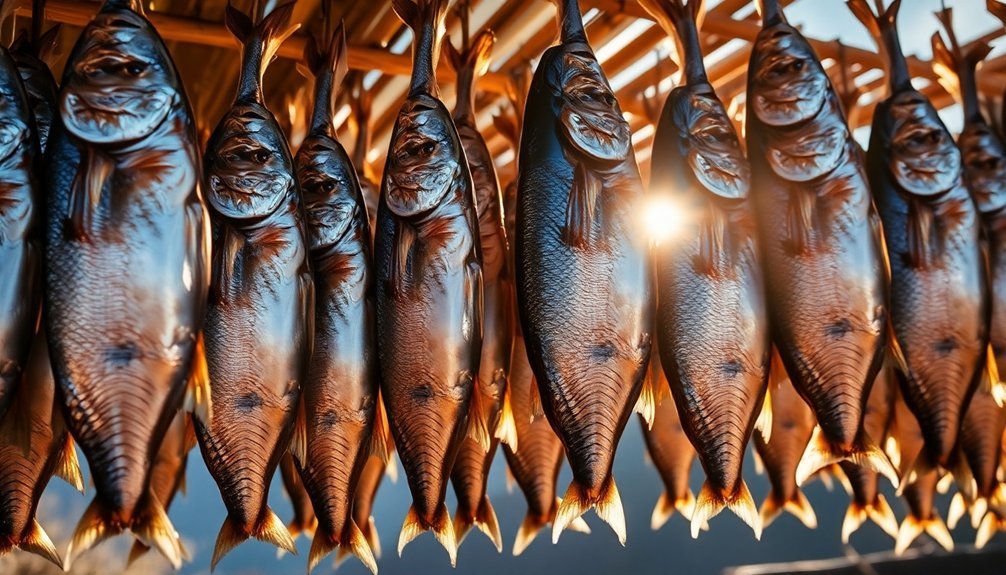
Throughout the year, seasonal variations play an essential role in Japanese fish sun-drying techniques. You'll find that cool weather conditions provide the most favorable environment for drying fish, as they help prevent spoilage while maintaining the product's quality.
When you're drying fish outdoors, you'll need to carefully monitor the process to guarantee it doesn't freeze or over-dry. Temperature control is critical for successful fish drying. You'll want to maintain cool temperatures and avoid extreme heat, though specific products like squid require temperatures between 40°C to 65°C at different processing stages.
If you're working in high temperatures, you risk compromising both texture and overall quality. The humidity levels in your drying area will greatly impact your results. You'll achieve better outcomes in low-humidity conditions with good ventilation, as this speeds up the drying process and prevents mold formation.
When you're dealing with high humidity, you'll need to adjust your drying time and methods accordingly. You'll also need to take into account the seasonal availability of different fish species. Whether you're working with mackerel, horse mackerel, or sardines, you'll need to adapt your drying techniques based on the season's typical weather patterns and the fish's natural availability.
Proper Storage After Drying
Once you've completed the drying process, proper storage becomes the next vital factor in preserving your sun-dried fish.
You'll need to store your dried fish in a cool, dry place away from direct sunlight to maintain its stability and prevent degradation. Using airtight containers or vacuum sealers will protect your fish from moisture and contaminants while ensuring it stays fresh for months or even years.
To maximize the shelf life of your sun-dried fish, follow these essential steps:
- Wrap each piece in waxed paper before placing it in storage containers to prevent contamination and moisture absorption.
- Store containers off the ground in a clean area that's free from insects and rodents.
- Monitor your stored fish regularly, checking for any signs of moisture or spoilage.
- Label your containers with the fish type and drying date for better tracking.
Remember to maintain consistent storage conditions and avoid overcrowding your containers, as proper air circulation is vital.
If you're planning for long-term storage, consider using desiccants to control humidity levels. You'll also want to store your fish in smaller portions, making it easier to access without disturbing the entire batch.
Common Mistakes to Avoid
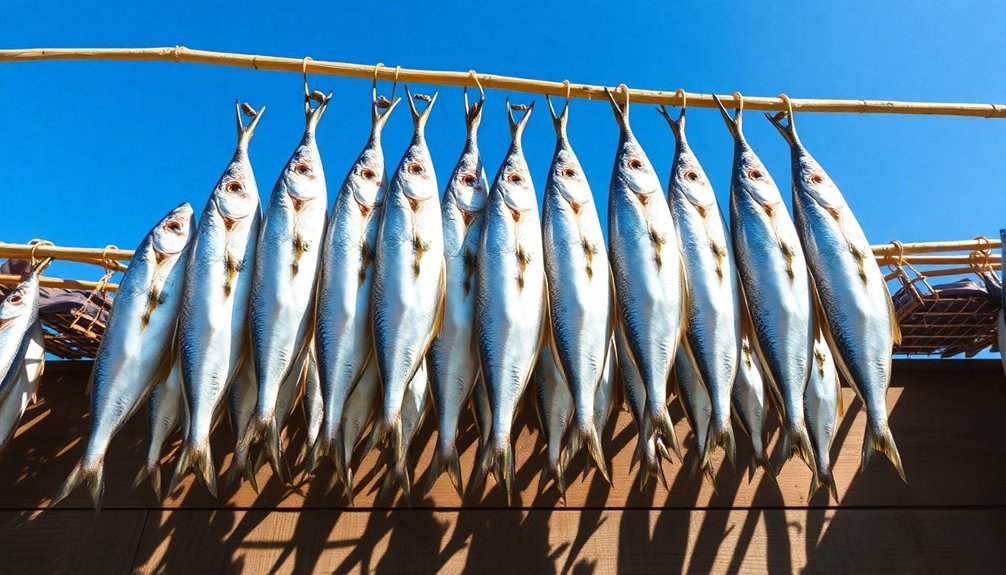
Successful sun-drying of fish requires careful attention to detail, and even experienced practitioners can make critical mistakes that compromise the final product.
You'll want to avoid improper handling techniques that can ruin your fish before the drying process even begins. Don't skip thorough gutting, descaling, and blood removal, as these oversights can lead to rapid spoilage. When you're cleaning the fish, guarantee you're patting it completely dry to promote even drying later.
The salting process is equally critical. You must use the correct salt concentration and maintain a consistent 20-30 minute soaking time. Make sure you're distributing the salt evenly and using appropriate preserving salt – table salt won't cut it.
During the drying phase, you'll need to monitor environmental conditions closely. Don't leave your fish in direct sunlight for too long, and guarantee proper ventilation throughout the process. Remember to turn the fish regularly for even drying.
Watch for signs of spoilage and adjust your process according to weather conditions. Using dirty equipment or ignoring traditional methods can lead to failure.
These mistakes aren't just minor inconveniences – they can render your entire batch inedible.
Health Benefits of Dried Fish
Dried fish packs four major health benefits that make it a nutritional powerhouse.
You'll be amazed at how this traditional preservation method concentrates nutrients while maintaining the food's essential properties. The drying process actually intensifies the nutritional content, making dried fish an incredibly efficient source of crucial nutrients.
- Superior Protein Content: You're getting a remarkable 62.8g of protein per 100g serving – that's equivalent to 10.5 eggs! This protein boost helps build and repair tissues while supporting your immune system and muscle health.
- Heart-Healthy Omega-3s: You'll benefit from concentrated omega-3 fatty acids that protect your heart, enhance brain function, and reduce inflammation, all while consuming only 5.9g of fat per cup.
- Essential Minerals and Vitamins: You're consuming a rich blend of calcium, vitamin D, B12, phosphorus, and iron in every serving, supporting everything from bone health to red blood cell production.
- Convenient Nutrition: You don't need refrigeration, and you're getting concentrated nutrients in a zero-carb, trans-fat-free format that contains just 82 calories per ounce, making it perfect for healthy snacking or cooking.
Regional Variations Across Japan

Beyond the impressive health benefits, Japan's rich geography and cultural diversity have shaped distinct regional approaches to fish drying. You'll find striking differences between Eastern Japan's Kanto region, where locals prefer softer textures and raw whitebait, and the Setouchi and Kansai regions, which favor harder, dried varieties.
The Seto Inland Sea's protected waters and climate create perfect conditions for whitebait production, with Awaji Island's Fukura harbor standing as a prime example. You'll discover dedicated chirimen factories dotting the Setouchi coastline, each preserving traditional methods while adapting to modern needs.
Each region proudly maintains its specialty himono products. In Numazu, Shizuoka, you'll encounter exceptional dried horse mackerel, while Toyama's known for its firefly squid himono.
Noto's distinctive whole-dried swordtip squid and Kagoshima's silver-stripe minnow showcase how local preferences influence preparation methods. These regional variations aren't just about taste – they're deeply rooted in history, with himono serving as currency for tax payments during the Nara era and becoming valuable trade commodities during the Edo period.
Today, while modern drying machines supplement traditional sun-drying, these regional distinctions continue to define Japan's dried fish landscape.
Frequently Asked Questions
Can Sun-Dried Fish Be Rehydrated to Restore Its Original Texture?
Yes, you can restore sun-dried fish close to its original texture through rehydration. The process works effectively because sun drying preserves muscle fiber structure, allowing better water absorption and texture restoration during reconstitution.
Does the Color Change During Sun-Drying Indicate Spoilage or Natural Processing?
Color changes during sun-drying can be both natural and spoilage-related. You'll see normal darkening from dehydration, but if you notice fungal growth or unusual discoloration with off-odors, that's likely spoilage.
Why Do Some Japanese Dried Fish Have Shiny, Silvery Surfaces?
You'll notice the shiny, silvery surfaces because of biogenic multilayer reflectors in fish scales. These are made of stacked guanine crystals separated by cytoplasm, which naturally create a reflective, metallic appearance.
Can Indoor Artificial Lighting Replace Sunlight for Traditional Japanese Fish Drying?
You can use artificial lighting to dry fish indoors, but you'll miss the unique flavor enhancement from natural sunlight and sea breeze. It's practical for production but may lack traditional qualities.
How Do Japanese Fishing Villages Prevent Seabird Interference During Outdoor Drying?
You'll find Japanese fishing villages use drying baskets, protective nets, and shaded areas to keep seabirds away. They'll also practice community monitoring, traditional timing methods, and regular fish turning for maximum protection.
In Summary
You'll find that Japanese sun-dried fish lasts remarkably well due to careful preparation, precise timing, and traditional expertise passed down through generations. The combination of salt treatment, controlled exposure to sunlight, and proper storage methods creates a preserved product that's both safe and flavorful. By following these time-tested techniques and avoiding common mistakes, you can enjoy dried fish's nutritional benefits while experiencing an essential part of Japanese culinary heritage.

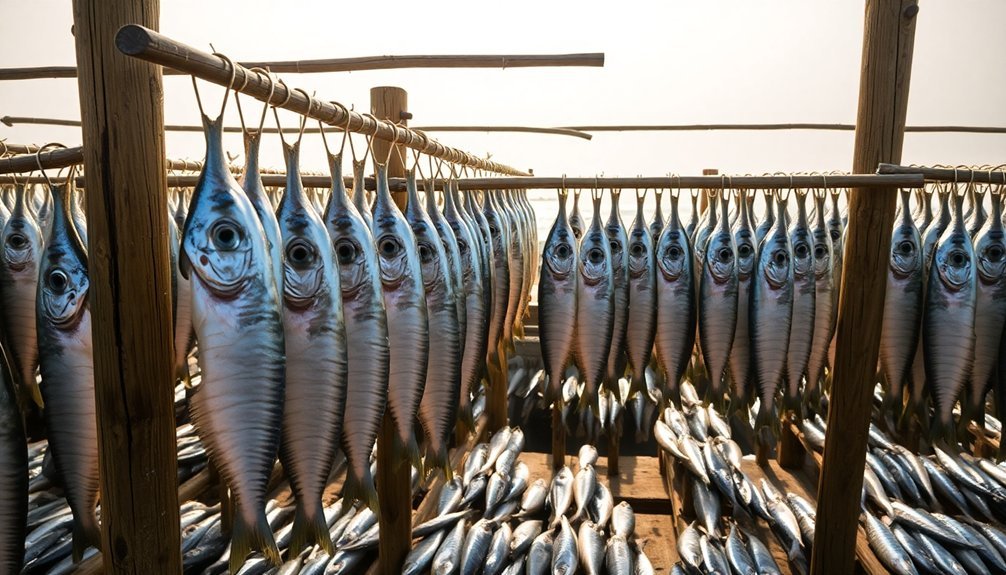



Leave a Reply